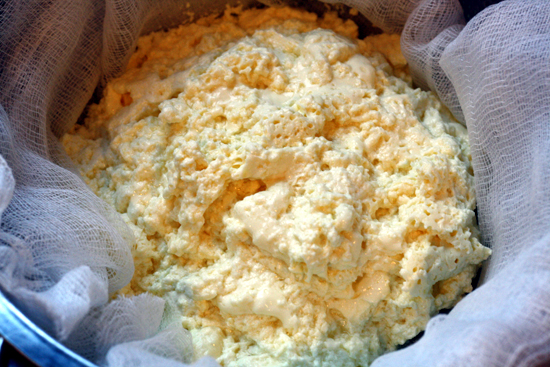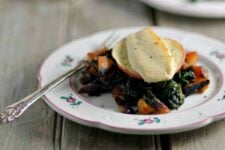If you’re wondering how to make homemade ricotta cheese, you’re in the right place. But first, let’s examine why the creamy staple is so timeless and tasty.
Ricotta cheese is among the most popular cheeses in the world. It’s incredibly versatile and can be used in many different dishes. Whether you want to toss a handful over pasta or pizza, you can’t go wrong with ricotta cheese.

But how do you make it at home? Below, you’ll learn how to make homemade ricotta cheese using simple, easy-to-follow instructions.
So read on to learn more about this delicious and versatile cheese!
What is Ricotta Cheese?
Ricotta is an Italian whey cheese created from the milk of cows, sheep, goats, or water buffalo.
You make it by reusing whey from the cheesemaking process, usually from mozzarella.
Whey is the cloudy liquid left over after making cheese, and ricotta puts it to great use. The name literally translates to “recooked” in Italian.
While true ricotta cheese uses the whey obtained from mozzarella production, you can easily make homemade ricotta using simple household ingredients.
Another reason to make homemade ricotta is that, unlike most cheeses, it’s not cultured. You can easily whip up a batch at home without shopping for a bacteria culture.
Ready to give homemade ricotta a try? Without further ado, let’s discuss the key ingredients and tools.
What You’ll Need:
Milk. Find milk that’s full fat, 3.25% whole milk is ideal. While it’s unsafe to drink raw milk, try to find a version that’s not ultra-pasteurized since the proteins have been destabilized. As a result, the calcium in the milk does not properly bond together and won’t curdle.
Salt. We recommend Himalayan or sea salt for higher-quality ricotta, but table salt will do just fine.
Lemon Juice or Vinegar. You’ll need an acidic component to help create those beautiful curds. Use lemon juice when using ricotta in sweet recipes or vinegar when using the cheese in savory dishes.
Thermometer. Find one with a long stem and an oven-safe dial like the KT THERMO thermometer.
Cheesecloth. We love the Olicity brand cheesecloth because it’s unbleached, reusable, and hemmed on both sides to reduce fraying.
Finely Slotted Spoon or Skimmer. You’ll need a slotted spoon or skimmer that’s finely slotted so ricotta curds don’t fall out.
How to Make Ricotta Cheese:
If you’ve been intimidated to make homemade ricotta cheese, we’ll break down the steps for you. After discovering how easy it is to make, you’ll have difficulty returning to storebought.
- Pour milk and lemon juice or vinegar into a large, heavy pot.
- Set the dial on your stove to low heat, then heat the mixture until it reaches 180°F or just before boiling.
- At this point, you should see tiny bubbles outlining the edge of the pan and curds beginning to form. Avoid stirring the mixture. Turn off the heat and cover the pan.
- Adjust your oven racks to make room for the pot, then set your oven temperature to 200°F. Allow it to preheat for a few minutes, then turn it off. Don’t worry about your oven reaching 200°F since we’re just trying to create a warm, insulated environment for the ricotta.
- Place the covered pot inside the oven, then leave it undisturbed for 5-6 hours.
- In the meantime, line a colander with 4 layers of cheesecloth and set it over a large bowl.
- Take the pot out of the oven and remove the lid. Using a finally slotted spoon or skimmer, gently scoop the curds from the pot and into the cheesecloth-lined colander. Continue until there’s just whey let in the pot.
- Season with 1/2 tsp. of salt, then mix and taste the cheese. Add another 1/2 tsp. if necessary.
- Now, decide if you’re trying to create a soft, spreadable, or a hard, firm cheese. If it’s the former, you can just let the mixture drain for a few minutes, whereas you’ll want to let it drain for several hours or overnight if it’s the latter.
You can use homemade ricotta cheese in many different recipes. Since it’s typically sweeter than storebought, you can use it in cheesecakes, ice cream, and other homemade sweets.
It also shines when served over fruits, figs, or scrambled eggs for a healthy, protein-packed breakfast. You can also use your homemade ricotta in more traditional Italian dishes like lasagna, pasta bakes, and casseroles.
Recipe Tips/Variations/Substitutions:
Substitute cotton fabric for cheesecloth. We get it, cheesecloth isn’t exactly a household item. If you don’t have time to go out and buy some, you can also use a pillowcase, scrap of fabric, bandana, cloth napkin, or gauze.
Reuse leftover whey. While you can’t use the leftover whey to make more ricotta, you can add it to bread, muffins, biscuits, and pizza dough. It adds a moist texture and sour tang to your baked goods.
Swap in cream for milk. If you want your ricotta to have a thicker texture, try replacing 1-2 cups of milk with cream. It will add even more creaminess to your cheese.
Replace lemon juice or vinegar with citric acid. If you have used up the last of your lemon juice or vinegar, you can swap in citric acid as your acidic component. Substitute 1/2 teaspoon of citric acid for 1/8 cup of lemon juice or vinegar. You find citric acid at specialty food stores or on Amazon.

Storing Leftovers:
Homemade ricotta spoils rather quickly, so you can either use it immediately or cover and refrigerate it for up to 3-4 days.
You can freeze ricotta, but it will lose that delicious fresh taste, and the texture will change. After thawing out, your once-creamy ricotta will become crumbly and dry.
If you use frozen ricotta, try using it in recipes like lasagna or casseroles, where the ingredients are baked together. Avoid using it on salads and raw dishes.
To store frozen ricotta, stow it in an airtight container for up to 3 months.
Try These Recipes Using Homemade Ricotta:
Frequently Asked Questions
Making homemade ricotta is an easy process with an incredible payoff. Not only is it slightly cheaper than buying ricotta from the grocery store, but it’s also sweeter, creamier, and fresher than store-bought.
If you want to indulge in some cheesy, ricotta is among the healthier choices since it’s low in fat and sodium and high in protein. The ultra-creamy texture makes it a delicious substitute for ice cream or mozzarella.
If your ricotta mixture doesn’t form clumps, don’t panic. You can fix this by pouring in more lemon juice or vinegar, one teaspoon at a time, and observing the reaction. After a few minutes, you should see curds starting to form.
If your ricotta cheese has a rubbery texture, you might’ve over-stirred while the curds were forming, causing the clumps to seize up and become gummy.
While Meyer lemon and ricotta go together like peanut butter and jelly in a recipe, you can’t actually use Meyer lemon to make homemade ricotta. Meyer lemons don’t have enough acidity to curdle the milk, so you’ll be left with lackluster cheese clumps.
Homemade Ricotta Cheese
Ingredients
- 1/2 gallon whole milk
- 3 tbsp fresh lemon juice or white vinegar
- 1/2 tsp salt
Instructions
- Heat milk and lemon juice or vinegar over very low heat in large heavy pot. Heat to 180°F, the temperature just before boiling. You will see tiny bubbles around the edge of the pan and you’ll notice curds beginning to form.
- Turn off the heat and cover the pan. Adjust your oven racks to make room for the pot and then heat your oven to 200°F for a few minutes. Turn the oven off, place the covered pot inside, and leave undisturbed for 5-6 hours.









